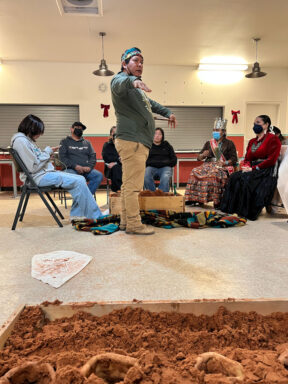CH’ÍHOOTSOOÍ, DINÉTAH, WINDOW ROCK, NAVAJO NATION – Yee Ha’ólníi Doo marked the Winter Solstice with a two-day cultural celebration held on December 21 and 22 at the Tsé Bii’ Ndzisgai Community Center in Monument Valley, Utah.
For Diné, the winter season ushers in a time of storytelling, games, and teaching that emphasize culture, language, and kinship.

The event included a traditional Keshjéé’ (shoe game), Tsidił (stick game), sheep butchering and cooking demonstration, an introductory Navajo language workshop, and winter storytelling.
Featured presenters included 2022-2023 Miss Navajo Nation Valentina Clitso, Malcolm McCabe, Lorissa Jackson, and Christine Rock.
For Yee Ha’ólníi Doo Executive Director Ethel Branch, these events are ways by which the Tsé Bii’ Ndzisgai Community Center fulfills its intention of ensuring transmission of language and culture to the next generation.
“I was thrilled by the attendance of community members who wanted to learn, reacquaint themselves, or just participate in the traditional aspects of our event that coincide with the season,” Branch said. “Every component had a traditional explanation, a call for questions, and credence given to audience insight and interpretation.”
On the first day, Lorissa Jackson provided an introductory Navajo language workshop and spoke only in Navajo.
“Today, our kids are not in an environment where they are being exposed to Navajo all the time, but this is how we learn the language. I didn’t learn it by studying it,” she said. “What I try to do is use that way of learning instead of always translating. The kids won’t learn if we keep translating stuff into English.”
The Keshjéé (shoe game) was the highlight of the first night and was explained and led by Malcolm McCabe. He presented a traditional story of the origin of Keshjéé, then went on to explain the game’s rules and scoring strategies.
McCabe said Keshjéé happens alongside many winter ceremonies where people travel far and wide to gather for healing purposes. The comradery and laughter are also healing.
“If you were able to go back 40 or 50 years ago and you went into your relatives hogan, it would be filled with talking, singing, and storytelling. Right now, during this season, we have Keshjéé. It’s much like all our other ceremonies,” McCabe said. “This is a way we all come together, reestablish our relationships, and have fun while also sharing winter stories.”
Miss Navajo Valentina Clitso kicked off the second day with a sheep butchering and food preparation demonstration that brought out participants from the surrounding Black Mesa, Kayenta and Monument Valley communities.
Clitso butchered two sheep and provided instruction on what she was doing. She gave insight into cultural taboos and proper etiquette in butchering.
“When you start, you have the sheep’s feet facing the east. When you’re preparing to butcher you make sure the sheep didn’t eat or drink water the night before,” she said. “There are other taboos like you shouldn’t be pregnant or menstruating while you butcher. These instances can cause the sheep to have a lot of blood when you cut the neck.”
Yee Ha’ólníi Doo Direct Relief Program Manager Mary Francis said people can also help by keeping the fire going, keeping water pots filled and warm, making bread, and keeping the dishes clean.
Christine Rock closed out the event with winter storytelling. Rock also agreed that it’s better to fully immerse students in Navajo as a way of learning.
“Nowadays, with the generation gap and children not knowing the language, it’s so much harder to become fluent. With the San Juan School District, we have a curriculum and that is to teach our lessons all in Navajo,” Rock said. “We try to move away from code switching but at times we have to because our younger generation don’t all understand Navajo”
Code switching is when you present something in Navajo but then must translate it into English.
“I think having community events like this is really good because it lets children experience things they might not experience at home or in the school,” she said. “Like with the shoe game, I hope the children were able to attend and see it.”
Yee Ha’ólníi Doo will open their second community center, the Tooh Haltsooi Community Center, in Sheep Springs, N.M., on January 7 at 10 a.m.
“These Centers serve as innovation hubs that will give flight to the rich, natural social and small business entrepreneurship that has always existed in our communities but has long lacked adequate support and resources to flourish. Our Community Centers will infuse communities with tools and programming designed to advance food security, incubate small business and social entrepreneurship, foster youth leadership, and strengthen traditional knowledge and fluency in our Diné language,” Branch said. “Through these centers, we’re building stronger, more resilient communities.”




